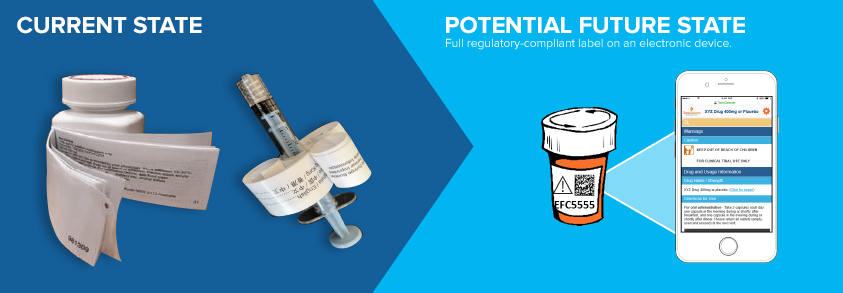In biopharma research and development, technology can play an important role in the labeling of investigational medicinal products (IMP). An electronic label, or eLabel, is the provision of a complete IMP label on an electronic device while still utilizing a simplified paper label on the physical packaging. The simplified paper label (a “Universal Label”) would contain minimal language neutral information (e.g. numbers and pictograms), required for identification, dispensing and safety purposes. As of January 2021, the eLabels Initiative is completed. There are no new deliverables or updates planned.
What is an eLabel?
The Art of the Possible
The purpose of the TransCelerate eLabels Initiative is to help all stakeholders progress on the journey of digitally supported label technology as well as move toward a more patient-centric approach. As part of this effort, the eLabels Initiative has created a toolkit intended to facilitate a clinical trial sponsor’s ability to implement eLabels. The eLabels Design and Delivery Toolkit includes a high-level roadmap of activities that can facilitate implementation, as well as feedback from key external stakeholders. TransCelerate is also working with Health Authorities to evolve regulatory requirements in a manner that would allow broad eLabels usage in clinical trials as reduction of the printed label content is not yet a viable option in all geographic locations.

Click on each section to navigate through the content.
The TransCelerate eLabels Initiative’s long-term goal is to enable the industry to transition as seamlessly as possible to using eLabels in conjunction with a simplified paper label. This universal label would generally contain minimal language, agnostic information and/or symbols that are universally understood and used for identification, dispensing and safety purposes. This design implication is the foundation to enhance patient benefits and enable future innovation. The Initiative has identified three themes for a modular design approach that may facilitate the use of eLabels during clinical studies. While a sponsor is free to use the approaches identified by TransCelerate, each company must independently decide which label design elements it wishes to implement.
Click on the graphic to learn more.
3. ADD ON
2. ENHANCE
1. FOUNDATION
- Enable innovation through added functionality to improve patient and site experience and enhance data integrity. Potential examples:
- Adherence reminders
- Features to simplify investigator sites processes such as receipt, inventory, management and accountability
- Sensors (e.g. temperature, humidity, compliance) to record real-time data
- Provide ability for real-time updates to label content
- Provide enhanced access to information about the investigational product, preparation, dispensing, storage and use
- In the future, links to multiple media types and languages could be added to enhance further accessibility
- Provide regulatory-compliant label content via a user-friendly, electronic equivalent with a simplified paper label
A universal label is a paper label that contains limited, language neutral information such as numbers and pictograms. It includes information required for dispensing medication at the site, safety information, provides a connection to the eLabels and may also include trial or molecule specific information. It’s important to note that the universal printed label concept is being discussed with global Health Authorities and acceptance of the concept is dependent on the regulations of each country, which are variable. Therefore reducing the printed label content is not yet a viable option in all geographic locations.

Companies considering an eLabels solution will want to consider many factors before implementing an eLabels technology including whether the potential solution will align with the company’s business practice, solution architecture and infrastructure, offers options that can stand alone while still providing enhanced benefits if used across the clinical supply chain and considers mechanisms that can be flexible, innovative and scalable. Overall, the technology assessment process can be approached in this manner and additional information on each step can be found in the Design and Delivery Toolkit.
Click on the steps to learn more about the process.
When exploring the technology options for an eLabels approach, consideration of an eLabels technical architecture and how it integrates with other clinical trial technologies will be a useful activity. An integrated technical architecture identifies the grouping and interaction of technology components and can enable data, application infrastructure, hardware and custom and packaged software to unify in a coherent structure of components and interfaces. Within the Design and Delivery Toolkit, an example technical architecture provides companies high-level guidance on which potential systems have a relationship to an eLabels system. The eLabels technical architecture below provides a suggested foundation of an eLabels system implementation which could evolve to include forward-thinking integration with other systems to aid in patient comprehension and convenience. Before you begin, learn more here and see some key considerations below:

Currently, no regulations preclude sponsors from using technology to provide label content in electronic format. so long as the printed label meets local regulations. However, in some geographic locations, utilization of an eLabel along with a universal label (which reduces the content on the printed label), may require those Health Authorities to consider modifying existing regulations.
The uptake of the universal label, in conjunction with eLabels, will likely increase over time as empirical data is generated from studies leveraging a universal printed label and an eLabel. Sponsors can also foster acceptance by Health Authorities, by levering an eLabel in parallel with a traditional paper label (see Stage 2 below) in geographic regions which do not allow the decrease in content on the paper label. Click here to view a summary of the TransCelerate eLabels Initiative engagements with Health Authority engagements since 2016.
The diagram below outlines a proposed approach to introducing eLabels for Health Authorities.

Patients and sites are key stakeholders in any eLabels approach. While a printed (booklet) label meets regulatory agency requirements, surveys indicate it has limited utility for patients and sites. As part of this initiative, TransCelerate reviewed previously conducted patient surveys and engaged with patient and site advocacy groups to gain feedback on the current use of paper labels and on eLabels concepts.
What Feedback Did Sites Provide?
To gain the site’s perspective, TransCelerate conducted a simulation of an Investigator Site meeting and an initial patient visit using an eLabel. The objective of the simulation was to understand how eLabels could be used by a clinical site to enhance and improve their ability to perform clinical trials and engage with patients. When shown eLabels proof of concept, sites unanimously liked the concept and features and offered the following as considerations when approaching an eLabels design:

Connection to existing systems
To allow efficiencies, connect new technologies to systems the site is already using.

Encourage patient engagement through technology
Identify meaningful ways to allow the patient to have regular interactions with the technology (e.g. alarms, site adding visit reminders).

Minimize hardware and/or software across a study
Reduce the introduction of multiple approaches, hardware, software and sign-ons as it increases complexity, decreases comprehension and increases the risk of error for both the patient and site.

Enable site personnel to be the experts
Provide sufficient training to site staff to allow them to be viewed as experts for patient facing technologies.

Enable site engagement and communication with a patient
Consider ways to enhance tools to facilitate connection with patients.

Value site storage
Consider the space challenges and the availability of room for packaging, hardware and other sponsor provided items.

Consider those who are technology adverse
The elderly, military, those with limited finances, and those concerned with patient privacy can be technology averse at times which requires continuation of printed materials agnostic to technology comprehension.
For more information on the site’s perspective, click here.
What Feedback Did Patients Provide?
TransCelerate engaged a Patient Advisory Group for one year to obtain feedback on the eLabels concepts including perspectives on usability, pictograms and proof of concept examples. The Patient Advisory Group expressed dissatisfaction with current labels (i.e. booklet and single panels) citing a multitude of concerns including small font sizes, difficult to open booklets and that it doesn’t contain the information they need. The group’s feedback regarding the eLabels proof of concept was much more positive than the user of current labels. Patients cited a “clean and simple” design, easy to use search functionality, native language capabilities and increased ease of access for patients with physical, visual or auditory challenges. Patients offered the following:

Content and contacts
Patients agreed with foundational content in the eLabels proof of concept they were shown and additionally suggested including:
- Dosing instructions (especially important when taking multiple medications and/or IMP/placebo from multiple containers)
- Sponsor name
- Key contact Information (e.g. study nurse, patient advocate, etc.)
- Adverse event information

Design and features
Patients appreciated:
- “Clean and simple” design
- Search function
- Ability to select a native language (even when traveling)
- Modern functionality and notifications
Patients suggested:
- Ability to easily make calls from contact information provided
- Ability to scan only one time
- Individual site location and preference information could be pulled from mobile settings
- Single App for eLabels and medication diary

Access
- For other family members/caregivers
- To study medication name and dosage information post-study
- By emergency room and hospital personnel

Pictograms
- Consistency across pictograms use such as:
- Shapes (e.g. triangles and squares)
- Use of “X” versus a slash to indicate “do not”
- Outlines around pictograms are not necessary
- Pictograms on a white (vs. black) are easier to recognize
- Use of patient-centric text or layman’s terms
- Simplicity is preferred versus overly complicated pictograms
- Use of color was perceived to be beneficial
- Availability of a “pictogram glossary” was considered as helpful
- Ensure the pictogram enabling connection to the eLabels indicates additional information is available through that access point
The publication provides an overview of concepts, defines terminology and offers a discussion about the misconceptions related to the use of both eLabels and universal labels
A high-level roadmap of activities that facilitate voluntary implementation of eLabels
A template which can be used in support of developing an eLabels business case within an organization
A handout detailing stakeholders’ issues with the current labeling process and how adopting eLabels will allow you to address each problem
A handout illustrating the cycle time improvement of the eLabels model vs. the conventional model
A template that can be used to assess all systems that may be impacted by an eLabels implementation
A template that can be used to develop necessary roles and resources needed for eLabels implementation and support
An index defining the key terms used within the eLabels toolkit and related resources
A document detailing FAQs surrounding the implementation of eLabels

